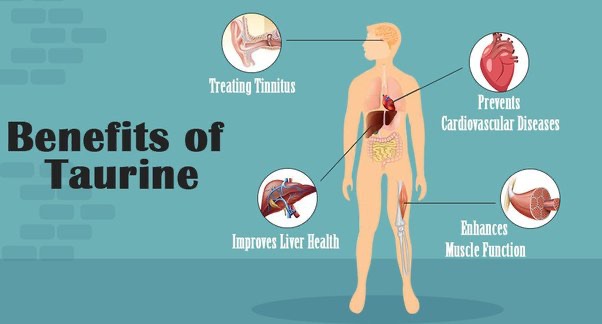
By Prof. Raphael Nyarkotey Obu
One study by Jong et al.(2021) found that taurine is a naturally occurring sulfur-containing amino acid. It’s more found in the brain, eyes, heart, and muscles. The same study highlights that although amino acids are considered the building blocks of protein, taurine isn’t used to build proteins in the body.
It is regarded as a conditionally essential amino acid, meaning it becomes essential only in times of illness and stress.
Furthermore, taurine is not taken from bull semen or urine as previously propagated. it was first isolated in 1827 from the bile of an ox. The Latin name for an ox is Bos taurus, which is where the amino acid’s name originated.
Taurine is found in some foods, and your body can even produce it by itself. Therefore, taurine deficiency is unlikely in healthy adults.
However, because newborns and infants can’t make taurine as well as adults, they depend on taurine from breast milk or taurine-supplemented formula.
Taurine, Science
Diabetes
Some studies(Inam-U-Llah et al. 2018; Sirdah M. 2015; Sak et al. 2019) found that taurine’s antioxidant and anti-inflammatory properties could enhance insulin sensitivity, to reduce the risk of type 2 diabetes.
Sak et al. (2019) study found that people with diabetes have a 25% lower concentration of taurine as compared to those who don’t. This means that taurine could play a role in diabetes management.
Another study by Inam-U-Llah et al.( 2018) found that taurine could also support blood sugar levels in people with diabetes.
This same study found that taurine could protect those with diabetes-related complications such as nerve damage, kidney damage, and heart disease.
Heart health
One study by Qaradakhi et al.(2020) found that taurine supplements regulate blood pressure and improve heart function and blood fat levels in people with heart conditions such as heart failure. In large doses, it could also protect against heart disease.
Another study by Murakami S(2014) found a connection between higher taurine amounts and decreased cholesterol, lower blood pressure levels, and drastically lower rates of death from heart disease.
For instance, Ahmadian et al.(2017) found that those with heart failure who were given 500 mg of taurine three times daily for 2 weeks had decreased total cholesterol, triglycerides, and C-reactive protein (CRP) — an inflammatory biomarker — both before and after exercise, compared with those who took a placebo.
In a previous 12-week study by Sun et al.(2016) on those with high-normal blood pressure, the study found that 1.6 grams of taurine per day decreases systolic blood pressure (the top number) by 7.2 mmHg and diastolic blood pressure (the bottom number) by 4.7 mmHg compared with placebo.
Blood pressure
The same study also found that taurine reduced the resistance of blood flow in the blood vessel walls and enhanced the efficiency of skeletal and heart muscle contractions.
Boost exercise performance
Taurine can improve muscle contraction and delay muscle fatigue, hence may benefit from it.
Besides, taurine may increase fat burning during exercise to better fuel your performance.
For instance, a review of 19 studies explored the effects of taurine on athletic performance and found the following:
• increased oxygen uptake by the body
• increased time to fatigue
• reduced muscle damage
• improved recovery times
• improved strength and power
1-3 grams of taurine is the recommended dosage to see the benefits and should be taken between 1–3 hours before a workout for at least 6–21 days.
The authors also note that taurine’s effects on exercise performance are small and inconsistent.
Other health benefits
Some studies(Castelli et al. 2021; Rak et al. 2014; Hu et al. 2016; Jakaria et al. 2019) have found that taurine has the following benefits:
• Support eye health. Taurine’s antioxidants could deal with the oxidative stress associated with retinal degenerative diseases such as age-related macular degeneration.
• Support hearing. Taurine could avert the hair cells within the ear from becoming damaged, which is a key contributor to hearing loss.
• Support neuroprotective effects. The anti-inflammatory effects of taurine may reduce inflammation within the brain and combat neurodegenerative conditions such as Alzheimer’s disease.
• Support liver health. Taurine may have protective effects against chronic and acute liver injury.
Studies in this area are few.
Side effects and precautions
One study by Jakaria et al.(2019) found no negative side effects when used in moderation.
Another 2019 report found that the highest daily dose of taurine to consume is 3 grams per day. On the other hand, the European Food Safety Authority (EFSA) suggested in its 2012 guidelines that 6 grams per day is ideal to consume.
On the other hand, Boccanegra et al.(2020) study found the following side effects in humans:
• vomiting
• nausea
• liver pain
• headache
• stomach pain
However, we do not know if the side effects emanate from the amino acid or from another ingredient the consumer took when taking the taurine.
Some studies(Caine JJ and Geracioti TD, 2016; Deodhar et al. 2020) found no evidence that taking taurine and prescription medications causes side effects, it acts as a cytochrome P450 enzyme inhibitor.
Due to this, it can interfere with medications that rely on this enzyme to metabolize drugs, such as antidepressants, antiepileptic drugs, warfarin, and statins.
As such, if you’re using any medications, you should consult your doctor to find out whether there’s any risk associated with taking taurine.
Dosage
Two studies(Kurtz et al. 2021; Caine JJ, Geracioti TD, 2016) found that the dosage range for taurine is 500–3,000 mg per day.
EFSA report from 2012 suggests that up to 6,000 daily is safe, demonstrating its strong safety profile.
A dose of 3,000 mg per day will help you maximize the benefits while staying within a safe range (Jakaria et al. 2019). Powder or capsule forms are the best and most cost-effective way to get the benefits. Most capsule supplements contain 500–1,000 mg per serving, while powdered taurine can have 1,000–2,000 mg per serving.
Sources of taurine
Kurtz et al.(2021) study found that animal proteins such as meat, seafood, and dairy contain taurine. This is not found in plants, hence vegan or vegetarian diet consumers have less taurine.
Some energy drinks typically provide around 750 mg per 8-ounce (237-mL) serving (Caine JJ, Geracioti TD, 2016).
The form of taurine used in supplements and energy drinks is usually synthetic, meaning it’s not derived from animals. Therefore, it’s suitable for those eating a vegan or vegetarian diet (Caine JJ, Geracioti TD., 2016).
Take Home
Taurine is found in many organs and has widespread benefits. Jong et al. 2021; Kurtz et al. 2021; Wu G, 2020):
• maintaining proper hydration and electrolyte balance in your cells
• forming bile salts, which play an important role in digestion
• regulating minerals such as calcium within your cells
• supporting the general function of your central nervous system and eyes
• regulating immune system health and antioxidant function
Because taurine is a conditionally essential amino acid, a healthy adult’s body can produce a small amount required for these essential daily functions. So when one is sick, then, the body needs a higher amount.
Taurine is lower in those with heart or kidney failure and in premature infants who have been fed intravenously. These individuals may need to get taurine from food or supplements (Wu G, 2020).
Animal models(Jong CJ et al. 2021) found that taurine deficiency causes eye damage, chronic liver disease, muscle weakening, and an increased risk of developing diabetes





